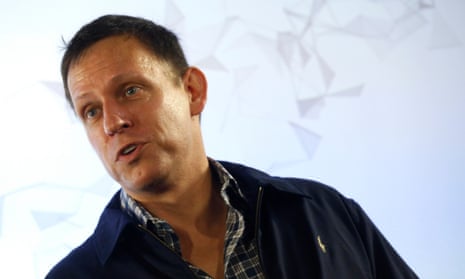by Stavroula Pabst, Unlimited Hangout:
 As war in Ukraine continues, controversial defense contractors and adjacent companies like Palantir, Anduril, and Clearview AI are taking advantage to develop and level-up controversial AI-driven weapons systems and surveillance technologies. These organizations’ common link? The support of the controversial, yet ever-more powerful Silicon Valley billionaire Peter Thiel.
As war in Ukraine continues, controversial defense contractors and adjacent companies like Palantir, Anduril, and Clearview AI are taking advantage to develop and level-up controversial AI-driven weapons systems and surveillance technologies. These organizations’ common link? The support of the controversial, yet ever-more powerful Silicon Valley billionaire Peter Thiel.
TRUTH LIVES on at https://sgtreport.tv/

“A reluctance to grapple with the often grim reality of an ongoing geopolitical struggle for power poses its own danger. Our adversaries will not pause to indulge in theatrical debates about the merits of developing technologies with critical military and national security applications. They will proceed.
This is an arms race of a different kind, and it has begun.”
– Alex Karp, Palantir CEO
These were the recent words of Palantir CEO Alex Karp, proclaiming in the New York Times that the world has entered a new era of warfare with the rapid acceleration of Artificial Intelligence (AI) technologies. Playing on the recent release of the “Oppenheimer” movie by comparing the dawn of AI with the development of the atomic bomb, Karp argued that the growing role of AI in weapons systems has become “our Oppenheimer moment.”
In his op-ed, Karp states bluntly that this era is a new kind of arms race where inaction equals defeat, positing that a “more intimate collaboration between the state and the technology sector, and a closer alignment of vision between the two” is required if the West is to maintain a long-term edge over its adversaries.
Karp’s words are timely within the context of the ongoing conflict in Ukraine, which – from the beginning – has been a tech-fueled war, as well as a catalyst for further blurring the lines between nation states and the companies that own and operate such technologies. From Microsoft “literally mov[ing] the government and much of the country of Ukraine from on-premises servers to [its] cloud,” to Boston Dynamics’ robot dog, Spot, sweeping mines on the battlefield, as I recently reported for Unlimited Hangout, “much of Ukraine’s war effort, save for the actual dying, has been usurped by the private sector.”
But, as Karp’s words suggest, the longer the conflict goes on, the more technologically advanced the weapons, and weapons operating systems and software behind them, will become. Indeed, the US Military is testing Large-Language Models’ (LLMs) capacity to perform military tasks and exercises, including completing once days-long information requests in minutes as well as extensive crisis response planning. Ukrainian Minister of Digital Transformation Mykhailo Fedorov, who commands Ukraine’s “Army of Drones” program in a made-for-film collaboration with Star Wars actor Mark Hamill, even recently proclaimed that the proliferation of fully autonomous, lethal drones are “a logical and inevitable next step” in warfare and weapons development.
Indeed, AI tech and other major technologies are coming to the forefront of the war’s front lines. For instance, “kamikaze” naval drones equipped with explosives dealt heavy damage to the Crimean bridge in July, with the Washington Post also reporting that over 200 Ukrainian companies involved in drone production are working with Ukrainian military units to “tweak and augment drones to improve their ability to kill and spy on the enemy.”
Read More @ UnlimitedHangout.com



